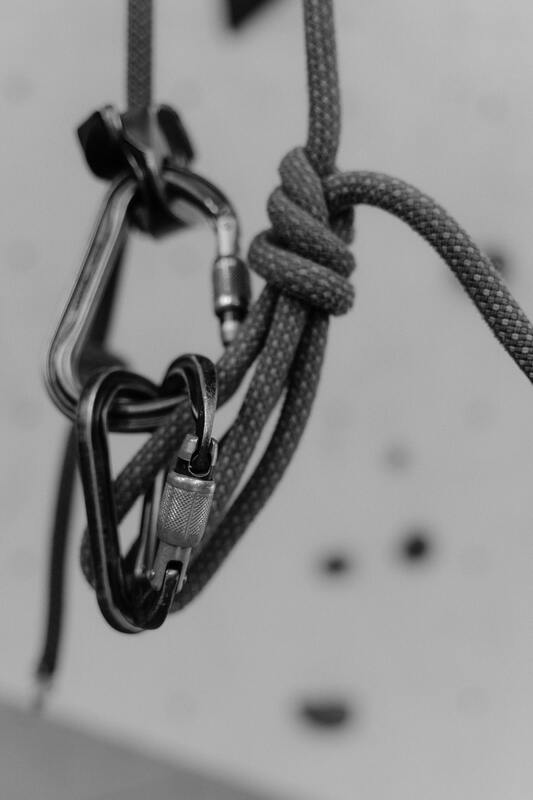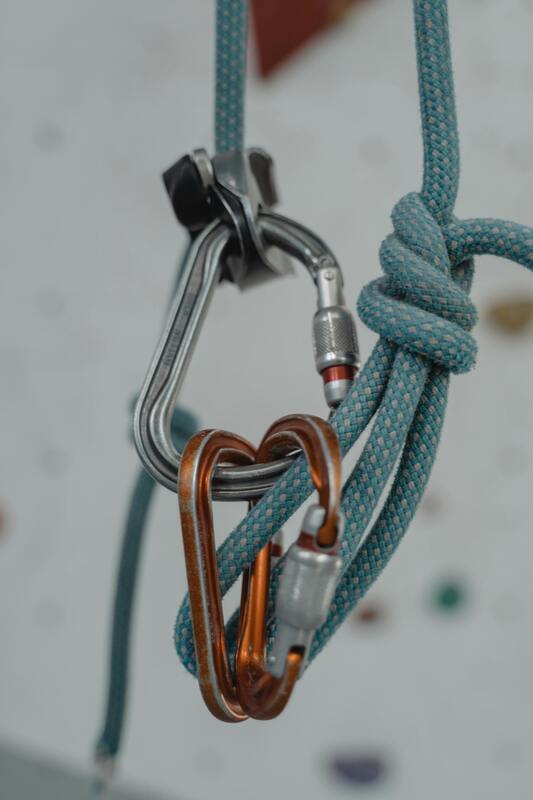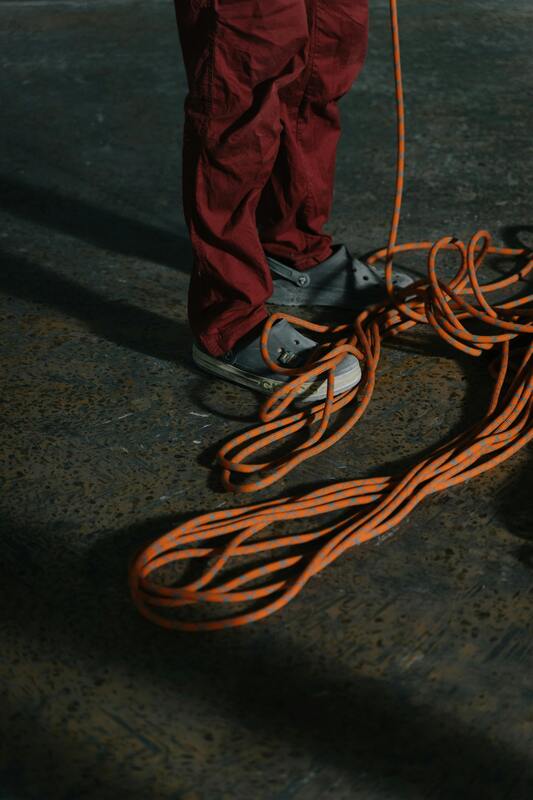Climbing ropes are super important for staying safe when you're climbing. Getting the right one, understanding what all the numbers mean, and taking care of it can be a matter of safety. Here's a breakdown of rope stuff, from types and lengths to knots and how to keep them in good shape:
**Climbing Rope Types**
* **Dynamic Ropes:**
* What they do: They stretch when you fall to soak up some of the force.
* Where to use them: Sport, trad, and indoor climbing.
* Thickness: Usually 8.5mm–10.5mm
* Thin ones (under 9.4mm): Light, but better for people who know what they're doing.
* Medium ones (9.5–10mm): A good choice, all around.
* Thick ones (over 10mm): They last a long time; good for beginners or lots of top-roping.
* **Static Ropes:**
* What they do: Barely stretch; good for rappelling, hauling stuff, or rescue stuff.
* Where to use them: Caving, rescue missions.
* Thickness: 9mm–13mm
* **Half Ropes:**
* What they do: You use two of them, clipping each one into gear.
* Where to use them: Trad and alpine climbing.
* Thickness: 8mm–9mm
* **Twin Ropes:**
* What they do: Clip both ropes into every piece of gear.
* Where to use them: Alpine and ice climbing.
* Thickness: 7mm–8mm
**Rope Lengths & Thicknesses**
| Type of Climbing | How Long? | How Thick? |
| :----------------- | :-------- | :----------- |
| Indoor/Gym Climbing | 40–50 m | 9.5–10mm |
| Sport Climbing | 70–80 m | 9.5–10mm |
| Trad/Alpine Climbing | 50–60 m | 8.5–10mm |
Shorter ropes are easier to carry and deal with. Longer ropes rock for climbs and long routes.
**Rope Treatments**
* **Dry Treatment:** Keeps water out, which is really useful for ice or wet climbing.
* **Sheath Treatment:** Makes the outside tougher, so the rope lasts longer.
**Knots You Should Know**
* **Figure-Eight Knot:** A safe knot to tie into your harness.
* **Alpine Butterfly Knot:** Makes a loop in the middle of the rope.
* **Prusik Knot:** A way to grip the rope so you can climb up it; used in rescues.
* **Klemheist Knot:** Like a Prusik, but you can tie it with webbing.
**Keeping Your Rope Safe**
* **Check It:** Look for worn spots, cuts, or faded colors.
* **Store It Right:** Keep it cool and dry. Keep it away from sunlight and chemicals.
* **Clean It:** Use mild soap or stuff made for ropes. Don't use strong cleaners.
* **Know When to Toss It:** If you take a big fall, see damage, or use it a lot for years, get a new one.
**Picking the Right Rope**
* **What kind of climbing?** Sport, trad, indoor, or ice?
* **How much experience do you have?** Thicker ropes are better when you're new.
* **Where are you climbing?** Get a dry-treated rope if it's wet.
* **How much can you spend?** Be safe first, but there's a lot of prices.
**Tips**
* Coil your rope nice so it doesn't get twisted.
* Mark the middle so you know where to put your anchors on long climbs.
* Try not to drag your rope over rough stuff, it will last longer.
**Climbing Rope Types**
* **Dynamic Ropes:**
* What they do: They stretch when you fall to soak up some of the force.
* Where to use them: Sport, trad, and indoor climbing.
* Thickness: Usually 8.5mm–10.5mm
* Thin ones (under 9.4mm): Light, but better for people who know what they're doing.
* Medium ones (9.5–10mm): A good choice, all around.
* Thick ones (over 10mm): They last a long time; good for beginners or lots of top-roping.
* **Static Ropes:**
* What they do: Barely stretch; good for rappelling, hauling stuff, or rescue stuff.
* Where to use them: Caving, rescue missions.
* Thickness: 9mm–13mm
* **Half Ropes:**
* What they do: You use two of them, clipping each one into gear.
* Where to use them: Trad and alpine climbing.
* Thickness: 8mm–9mm
* **Twin Ropes:**
* What they do: Clip both ropes into every piece of gear.
* Where to use them: Alpine and ice climbing.
* Thickness: 7mm–8mm
**Rope Lengths & Thicknesses**
| Type of Climbing | How Long? | How Thick? |
| :----------------- | :-------- | :----------- |
| Indoor/Gym Climbing | 40–50 m | 9.5–10mm |
| Sport Climbing | 70–80 m | 9.5–10mm |
| Trad/Alpine Climbing | 50–60 m | 8.5–10mm |
Shorter ropes are easier to carry and deal with. Longer ropes rock for climbs and long routes.
**Rope Treatments**
* **Dry Treatment:** Keeps water out, which is really useful for ice or wet climbing.
* **Sheath Treatment:** Makes the outside tougher, so the rope lasts longer.
**Knots You Should Know**
* **Figure-Eight Knot:** A safe knot to tie into your harness.
* **Alpine Butterfly Knot:** Makes a loop in the middle of the rope.
* **Prusik Knot:** A way to grip the rope so you can climb up it; used in rescues.
* **Klemheist Knot:** Like a Prusik, but you can tie it with webbing.
**Keeping Your Rope Safe**
* **Check It:** Look for worn spots, cuts, or faded colors.
* **Store It Right:** Keep it cool and dry. Keep it away from sunlight and chemicals.
* **Clean It:** Use mild soap or stuff made for ropes. Don't use strong cleaners.
* **Know When to Toss It:** If you take a big fall, see damage, or use it a lot for years, get a new one.
**Picking the Right Rope**
* **What kind of climbing?** Sport, trad, indoor, or ice?
* **How much experience do you have?** Thicker ropes are better when you're new.
* **Where are you climbing?** Get a dry-treated rope if it's wet.
* **How much can you spend?** Be safe first, but there's a lot of prices.
**Tips**
* Coil your rope nice so it doesn't get twisted.
* Mark the middle so you know where to put your anchors on long climbs.
* Try not to drag your rope over rough stuff, it will last longer.
1. Understanding Climbing Ropes
Not all climbing ropes are made the same. Things like how much they stretch, how strong they are, how thick they are, how long they are, and if they're treated all make a difference. To get the right one, think about the type of climbing you do, where you climb, and how good you are at climbing.
Here’s what to look at:
Stretch: Some ropes stretch a lot when you fall (dynamic), while others don't stretch much at all (static).
Diameter: This impacts how much the rope weighs, how long it lasts, and how easy it is to handle.
Length: How high can you climb before you need to come back down?
Treatment: This helps protect the rope from water, wear and tear, and dirt.
2. Rope Types
Dynamic Ropes
These stretch to soak up the impact if you fall.
Best for: Sport climbing, trad climbing, climbing gyms.
Diameter: Around 8.5–10.5 mm
Static Ropes
These don't stretch much and are made for going down or pulling things up.
Best for: Rappelling, rescue stuff, caving.
Diameter: Around 9–13 mm
Half Ropes
You use these in pairs, clipping them into different spots as you climb.
Best for: Big climbs with lots of sections and alpine climbs.
Diameter: Around 8–9 mm
Twin Ropes
You clip both of these ropes into the same spots as you climb.
Best for: Ice climbing, walking on glaciers, alpine routes.
Diameter: Around 7–8 mm
3. Choosing the Right Length & Diameter
Here's a quick guide:
Climb Type Length (meters) Diameter (mm) Notes
Indoor/Gym 40–50 9.5–10 Lasts long and is easy to use
Sport Climbing 70–80 9.5–10 Long enough for most climbs
Trad / Alpine Climbing 50–60 8.5–10 Light so you can carry it up long climbs
Ice / Glacier Climbing 50–60 8–9 Get one that's treated to resist water
Thinner ropes: Weigh less, easier to deal with, but don't last as long.
Thicker ropes: Last longer, good for beginners, but weigh more.
4.Rope Treatments
Dry Treatment: Keeps water out, great for wet, icy, or mountain climbs.
Sheath Treatment: Makes the outside tougher, so the rope lasts longer.
Core Treatment: Some ropes have treated insides that add to how tough and strong they are.
5. Must-Know Knots
Figure-Eight Knot: A safe knot for attaching the rope to your harness.
Alpine Butterfly Knot: Makes a loop in the middle of the rope.
Prusik Knot: A knot that grips the rope, which you can use to climb up it.
Klemheist Knot: Another gripping knot for using with webbing or to go up ropes.
6. Rope Safety and Keeping it Good
Checking: Before each climb, look for fuzzy spots, cuts, or soft areas.
Putting Away: Keep it in a cool, dry, dark place; keep it away from harsh chemicals or anything sharp.
Washing: Use light soap; rinse well.
Don't Drag: Keep it off rough rocks, so the outside doesn't get torn up.
When to Toss: Get a new one after a big fall, if you see damage, or if you've used it a lot for 5–10 years.
7. Tips for Handling Ropes
Coiling: This stops it from tangling; learn how to coil it like a butterfly or like a mountaineer.
Marking: Mark the middle, so it's easier to rappel or set up anchors.
Protecting: Use rope bags or sleeves to keep it safe from sharp edges.
Keep out of the Sun: The sun can mess with the rope fibers over time.
8. Rope Comparison Table
Rope Type Stretch Best Use How Long it Lasts Good Stuff Bad Stuff
Dynamic A lot Climbing, climbing gyms Okay Soaks Up falls Wears Out Faster
Static Not Much Rappelling, hauling Long Strong Not for falls
Half Medium Long climbs Okay Light Need to know what you're doing
Twin Medium Mountain, Ice climbing Long Back Up Need 2 Ropes


